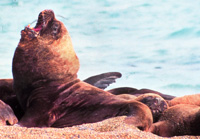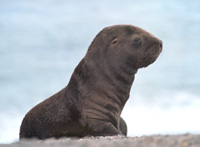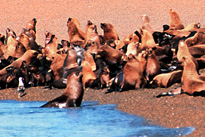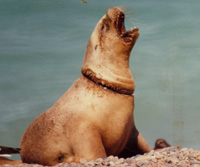South American Sea Lion
(Otaria flavescens)
IUCN STATUS (2010) - LEAST CONCERN
| Distribution and Numbers Also known as the Southern sea lion, and referred to by some scientists as Otaria byronia, the South American sea lion is found along the coasts and off-shore islands of South America. The limits of its range are Zorritos in northern Peru and Ilha dos Lobos in southern Brazil, although wandering individuals have been found as far north as Ecuador and the Galapagos Islands. Population figures for the species are incomplete. However the overall population is estimated to be about 265,000, consisting of roughly 30,000 in Peru, 128,500 in Chile, 90,000 in Argentina, 12,000 - 15,000 in Uruguay, 3,000 in the Falkland Islands, and a few hundred in Brazil. The populations in Uruguay and the Falkland Islands are decreasing rapidly while in most of Argentina and Chile they are increasing at an annual rate of around 3%. The species has no breeding colonies in Brazil, the small number of individuals found there having originated from the Uruguayan and Argentinean colonies to the south. |
 Photo: Miguel I��guez, Fundacion Cethus |
| Status Many hundreds of thousands of South American sea lions were killed by commercial hunters in the 19th and 20th centuries, some until as late as the 1950s, and several populations were heavily depleted as a result. There is currently no commercial hunting of the species within its range, although pressure exists in several countries to resume such hunting. |
| South American sea lions interact with fisheries over much of their range, and this problem looks set to increase as intensive fishing reduces available fish stocks. Fishermen claim that the sea lions damage their nets and catch in the coastal gillnet, longline and squid jig fisheries. As a result many sea lions are shot by these fisheries, despite regulations against such shooting in most countries. There are also widespread interactions with trawl fisheries, the opportunistic male sea lions often following trawl boats and being shot or becoming entangled in the trawl nets. Drift gill net fisheries may also result in the bycatch of sea lions when deployed along their transit routes. Dynamiting of South American sea lions has been reported from Brazil and Peru. Increasing levels of sea lion mortality are also associated with the rapidly expanding salmon farming industry, especially in Chile, sea lions becoming entangled in the protective nets around the farms or being shot by fish farmers to protect their stocks. In 1999 the Chilean government extended a moratorium on the killing of South American sea lions for an additional five years, the original moratorium having been instituted in 1994. There has been evidence in the past of fishermen in Chile and, to a lesser extent, Argentina, killing sea lions as bait for the king crab fishery, but it is not known if this practice continues. |
 Photo: Miguel I��guez, Fundacion Cethus |
In 1997 Uruguayan fishermen called for a cull of sea lions to protect fisheries. However the Uruguayan National Institute of Marine Fisheries has stated that it has no intention of carrying out such a cull. A similar call was made in 1997 by Peruvian fishermen who were, in turn, accused by conservationists of wanting to kill the sea lions so that they could sell the male sea lion genitals to the lucrative Asian aphrodisiac market. The Peruvian Fisheries Ministry was considering a pilot programme to kill up to 60 sea lions. However, as a result of the 1999-2000 El Nino event the numbers of sea lions onshore were drastically reduced and the programme was abandoned Scientists have discovered that sea lions at the port of Mar del Plata, Argentina, are badly affected by toxic chemicals and heavy metals, and are suffering from complaints such as skin infections, conjunctivitis, rhinitis and alopecia. |
| South American sea lions on the Pacific coast are badly affected by El Nino events. It has been reported that populations of sea lions in Peru and Chile have been decimated as a result of the 1997-98 El Nino. For example, it is thought that only 30,000 of the 180,000 sea lions that lived along Peru's coastline before the 1997-98 El Nino now remain. Some of these sea lions will have left in search of fish in colder waters so no firm estimate of mortality is yet available. A large proportion of dead sea lions in Peru were adult females, indicating that the recovery rate of the population would be much slower than for previous El Ninos. In northern Chile the 1997-98 El Nino affected mainly pups and juvenile sea lions aged 1-3 years old. The effects of the El Ninos are probably exacerbated by intensive fishing for important sea lion prey species such as anchovies. |
| In 1999 UNESCO's World Heritage Committee designated Argentina's Peninsula Vald�s, an important site for the species, as a World Heritage Site. |
| Lifestyle South American sea lion males start arriving at the breeding beaches in December in order to compete for territorial space. Each territory in the large rookeries that develop will contain an average of 3-6 females. Males who are unable to establish territories often attack undefended females and pups, and also sometimes attempt to mount, and in doing so kill, female and young South American fur seals. Most pups are born about 3 days after the mother's arrival at the rookery, from mid-December to the end of January (from the end of January to the end of February in northern Chile). The pup is born with a black coat that will turn brown to reddish-brown after a few months. The mother usually mates about 7 days after giving birth, and then leaves her pup in order to feed at sea. This begins a cycle, lasting 6-12 months, in which the mother forages at sea for about 3 days and then nurses her pup on shore for about 2 days. Pups enter the water at about 3-4 weeks for the first time and are good swimmers by the time they are 2 months old. |
 Photo: Enrique Alberto Crespo, Centro Nacional Patag�nico |
| Individual sea lions, usually males, are known to wander very large distances outside the breeding season, and some have even been observed on South Pacific islands and as far north as Salvador, Bahia in northern Brazil. Adult sea lions have a dark brown back and yellowish-brown front, the males having a lighter coloured mane and the females having lighter coloured fur on the head and neck. The males have a massive head and neck with a characteristically upturned nose. South American sea lions seem to be opportunistic feeders, tending to feed on demersal, pelagic and bottom species. Females normally feed in coastal areas and upon a wider number of prey species than the males. Prey is diverse over their range but includes a large number of fish species, cephalopods and crustaceans. South American sea lions are preyed on by sharks and killer whales. |
 Photo: Miguel I��guez, Fundacion Cethus |
Statistics There is some variation in body size over the species' range. Adult male South American sea lions measure an average of 2.6m long and weigh around 300kg, while adult females measure an average of 1.8-2m long and weigh around 150kg. Male pups are born weighing an average of 13.7kg and measuring 82cm in length. Female pups are smaller, weighing an average of 12.3kg and measuring 79cm. Females reach sexual maturity at 4-6 years, males at 5-6 years, although males only first achieve territorial status at 9-10 years. South American sea lions live for about 20 years. |
